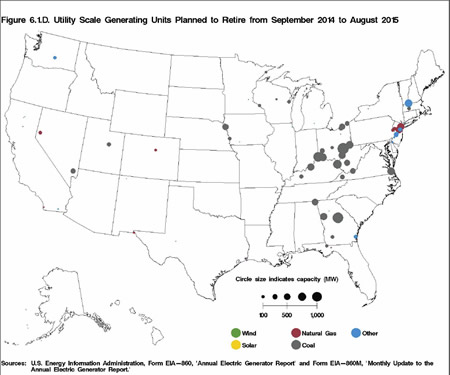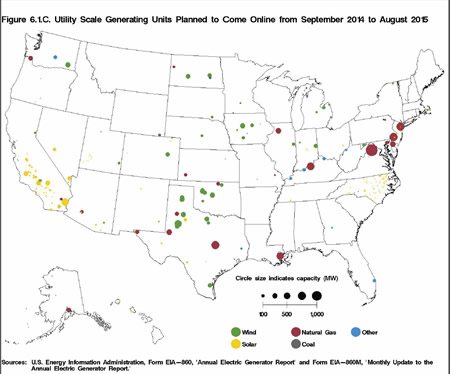Welcome to the
Run on Sun Monthly Newsletter

In this Issue: |
October, 2014
Volume: 5 Issue: 10
Myth Debunked: Renewables Replacing Dirty Energy!It is sometimes said that renewable energy sources, particularly solar and wind, can never replace fossil fuels. Turns out, they already are and we have the charts to prove it! (H/T CleanTechnica) The data comes from the monthly report on electric power supply sources produced by the U.S. Energy Information Administration, titled Electric Power Monthly, August 2014 (the latest report available). To be sure, the EPM report is a geek's delight, consisting of more than 200 pages of tables and graphs. But here is the part that caught our attention - it is a tale of two maps, showing power plants set to retire compared to power plants set to come online over the next year. Let's start with the retirees (click on the map for a full-size version)... That is a lot of capacity that is set to go away - what will take its place? So glad you asked, check this out... Those installations are helping to keep the demand for power down, meaning that you can eliminate more sources of power than you are adding and still meet the need. This is the trend that we need to see - more and more dirty energy sources being retired, replaced by fewer, cleaner power plants. So the next time someone tries to tell you that renewable energy sources will never replace fossil fuels, show them these maps and tell them, "You know what? They already are!" |
“This is the trend that we need to see - more and more dirty energy sources being retired, replaced by fewer, cleaner power plants…”
Get your copy of
Commercial Solar:
Step-by-Step
from
Run on Sun
Founder & CEO
Jim Jenal

Now available on Amazon.com
in both
Print & Kindle versions.
Bonus - Buy the Print version…
Get the
Kindle version for Free!
Commercial Solar:
Step-by-Step
from Run on Sun
Founder & CEO
Jim Jenal

Now available on Amazon.com
in both Print & Kindle versions.
Get the Kindle version for Free!
2014 - Warmest Year Ever?The scientists over at NASA are reporting something that folks out here in the West will not find at all surprising: 2014 is on track to contend for the title of warmest year ever. (No doubt this will come as a shock to folks who regularly watch Fox News.) (H/T Climate Crocks.) Of course, 2014 isn't over yet so the dotted lines provide a number of possible scenarios. To give you a sense of how far "ahead" we are so far this year, if the remaining months simply hit their 21st century averages, 2014 will tie 2005 for the second warmest year ever. Hang on to this link, you may need to refer to it next month over Thanksgiving dinner! |
Keeping the Lights on...We stumbled upon an interesting graphic that highlights just what it takes to keep the lights on in our homes and work places. It is a tale of both efficiency and waste. We thought it was worth sharing... (h/t The EnergyCollective.)
The starting point for the graphic (click on the image above for the full size graphic) is an old fashioned (i.e., wasteful) 100 Watt incandescent light bulb. If you turned on such a light and left it running for a year, how much energy would it consume? That's the easy calculation: 100 W = 0.1 kW. There are 8,760 hours in a year (roughly - don't go getting all leap year on me) so our light bulb uses: Quite a lot, really, just to light a room! The graphic proceeds to explore what it would take to produce that much power from each of our common energy sources. Interestingly, only one of these sources is something you can own - and that, of course, is solar. (While you could own a wind turbine, the one in the graphic is a 1.5 MW turbine, definitely not something to put in your backyard!) To be fair, the graphic assumes an installation of 100 square meters which is 1,076 square feet, and that is significantly larger than most residential solar systems. If your system is smaller, it takes longer for your system to keep the light on, but the end result is the same: your own power source meeting your needs, with no pollution or long-lived waste products to worry about. On the other end of that scale is the coal plant where our light bulb requires us to burn nearly half a ton of coal and emit over a ton of CO2 in the process! The good news is that both that wasteful incandescent light bulb, and coal-fired power plants are going away, just not fast enough. (Changing out your old 100 Watt light bulbs with efficient LEDs will drop these numbers by more than a factor of five.) Every solar installation directly reduces our greenhouse gas emissions - and saves the system owner substantial amounts of money over the lifetime of the system. |




